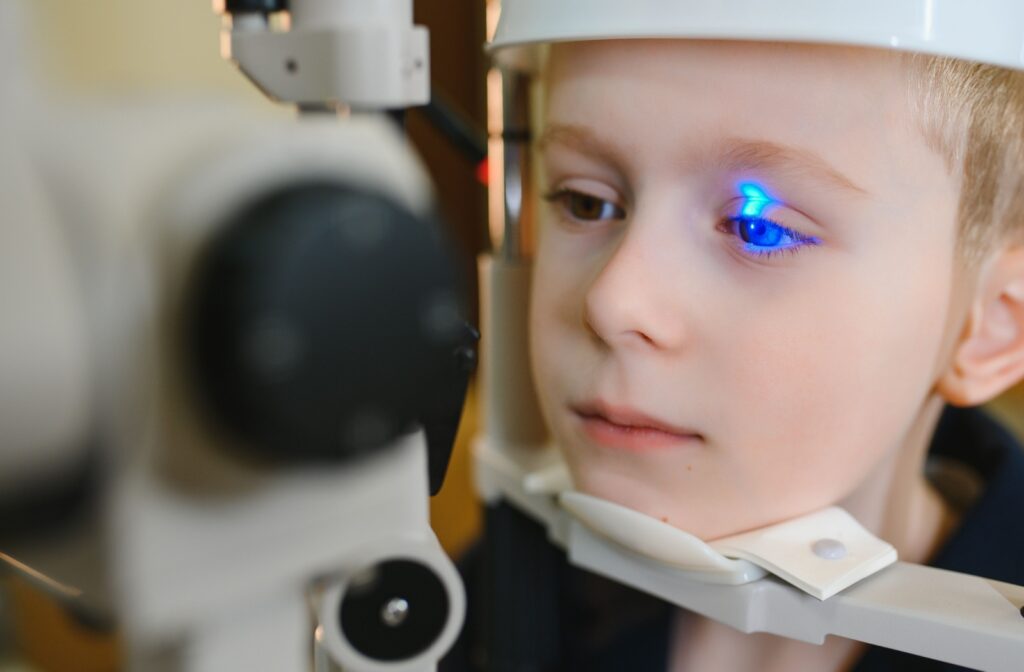As a parent, you pay close attention to your child’s health and development, from their first steps to their first day of school. Their vision is a fundamental part of how they learn and interact with the world around them. Identifying potential eye problems early can make a significant difference in their overall well-being and is a key part of our comprehensive approach to eye care.
The most effective way to protect your child’s vision is by recognizing subtle physical and behavioral signs and scheduling regular comprehensive eye exams. Many common childhood eye conditions can be addressed successfully when found early.
How to Tell if Your Child Has an Eye Problem
You know your child’s habits and personality better than anyone. Sometimes, small changes in their behavior or the appearance of their eyes can point to an underlying vision issue. Paying attention to these clues is the first step in protecting their sight.
Physical Signs in the Eyes
Look for any consistent changes in how your child’s eyes appear. These signs can be indicators that it’s time for a check-up:
- Persistent redness or watery eyes
- Crusting or discharge on eyelids
- Eyes that appear crossed or misaligned, which can be a sign of strabismus
- One eye that wanders inward or outward
- Droopy eyelids
- Cloudy or discolored pupils
- Unequal pupil sizes
Behavioral Clues to Notice
A child’s actions can also reveal a struggle with their vision. They may not know how to tell you something is wrong, but their behavior often tells the story. Some signs to look out for include:
- Frequent squinting or blinking
- Tilting their head to see things
- Covering one eye to read or watch something
- Sitting very close to the television or holding books near their face
- Frequent headaches as the brain works harder to interpret blurry images; learn more about how vision issues can cause headaches
- Difficulty with hand-eye coordination in play or schoolwork
Common Causes of Vision Disorders in Children
Several conditions can affect a child’s developing vision. Many of these are quite common and can be managed effectively with early attention. These issues often relate to how the eyes focus light or how they work together as a team.
Refractive Errors
Refractive errors change how the eye focuses, which can cause blurry vision. They are a primary reason children may need glasses. Some common refractive errors include:
- Nearsightedness (Myopia)—Makes it hard to see things far away. Fortunately, modern myopia control programs can help manage its progression.
- Farsightedness (Hyperopia)—Makes it difficult to see objects up close
- Astigmatism—Causes blurry vision at all distances due to the eye’s shape
Amblyopia or “Lazy Eye”
This condition, technically known as amblyopia, occurs when the brain begins to favor one eye over the other. Over time, this can cause the vision in the less favored eye to weaken. Early action can help retrain the brain and eye to work together.
Strabismus or “Crossed Eyes”
Strabismus occurs when the eyes are not aligned and do not focus on the same object simultaneously. Proper alignment is important for depth perception. Treatment can help the eyes work together as a team.

The Role of Genetics and Family History
Your family’s health history can offer valuable clues about your child’s eye health. Certain eye conditions can be passed down through generations. Sharing this information helps your eye doctor get a more complete picture.
Common Genetic Eye Conditions
If you or other close relatives have a history of eye conditions, your child may have an increased chance of developing them. This can include refractive errors, such as myopia, or conditions like strabismus. This is particularly important for conditions like high myopia, which can increase the risk of other eye diseases later in life.
Why You Should Share Your Family History
When you talk to your child’s eye doctor, be sure to mention any eye conditions that run in your family. This context allows them to be more thorough during an exam. It helps them know what specific signs to look for.
Screen Time and Its Effect on Kids’ Eyes
Digital devices are a part of modern childhood, from schoolwork to entertainment. While screens offer many benefits, extended use can sometimes lead to digital eye strain. Encouraging healthy habits can help keep their eyes feeling good.
Signs of Digital Eye Strain
Long periods of screen use can sometimes cause discomfort. You might notice your child experiencing a few common symptoms, such as:
- Dry or irritated eyes
- Eye fatigue
- Headaches
- Blurred vision
Tips for Healthy Screen Habits
You can help your child find a comfortable balance with their digital devices. Small adjustments can make a big difference in reducing eye strain:
- Encourage frequent breaks; try the 20-20-20 rule. Every 20 minutes, have them look at something 20 feet away for 20 seconds.
- Adjust the screen brightness to match the ambient light in the room.
- Position screens to avoid glare from windows or overhead lights.
- Promote plenty of time for outdoor play and other activities away from screens.
What a Pediatric Eye Exam Involves
A comprehensive eye exam is a key part of your child’s overall health care. It can identify potential issues that may not have obvious signs. The exam itself is designed to be a comfortable and even fun experience for children.
Why Routine Eye Exams Matter
Children often assume that how they see is how everyone sees. They may not know how to report a vision problem, or even realize they have one. A routine exam can detect issues before they impact their performance in school or their confidence in activities, identifying problems that simple vision screenings often miss.
A Look at a Child-Friendly Exam
Exams for kids are different from those for adults. We often use shapes, pictures, and fun games to check vision and eye health. This approach helps us get an accurate assessment in a way that feels engaging and not intimidating for a young person. You can even prepare for your visit by reviewing our patient forms ahead of time.
Supporting Your Child’s Vision
Taking a proactive approach to your child’s vision is a wonderful way to support their growth and development. If you’ve noticed any of the signs mentioned or it’s simply time for a check-up, our team at Total Vision Richmond is here to help. As your local eye doctor in San Francisco, we look forward to caring for your family’s vision.
Schedule your next visit today.


